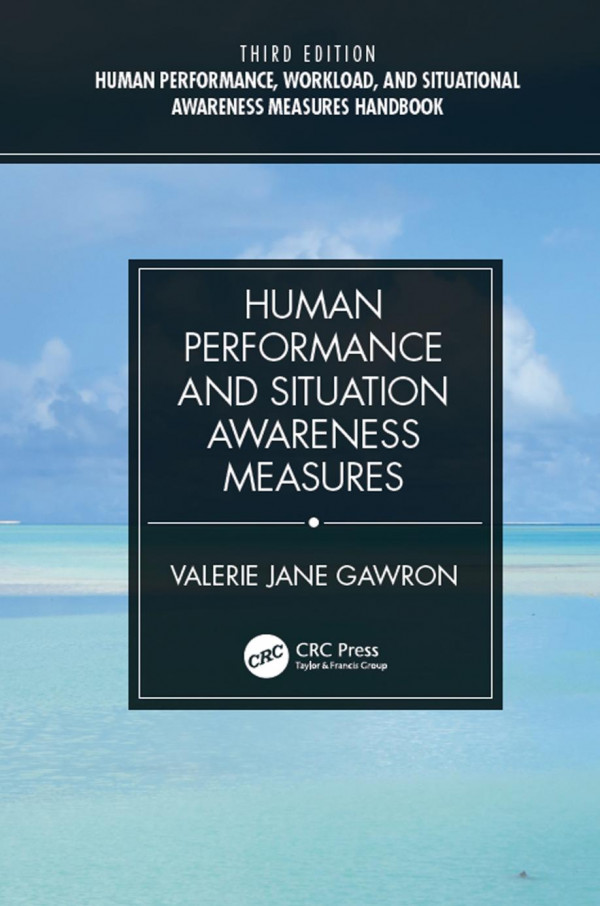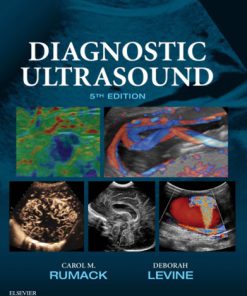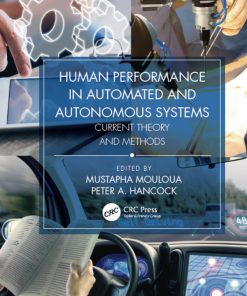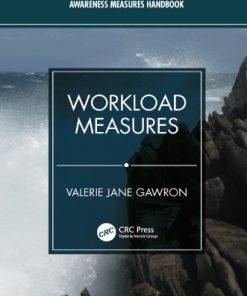Human Performance Workload and Situational Awareness Measures Handbook 2 Volume Set 3rd Edition by Valerie Jane Gawron 042967273X 9780429672736
$50.00 Original price was: $50.00.$25.00Current price is: $25.00.
Human Performance Workload and Situational Awareness Measures Handbook 2 Volume Set 3rd Edition by Valerie Jane Gawron – Ebook PDF Instant Download/Delivery:9780429672736,042967273X
Full download Human Performance Workload and Situational Awareness Measures Handbook 2 Volume Set 3rd Edition after payment

Product details:
ISBN 10:042967273X
ISBN 13:9780429672736
Author:Valerie Jane Gawron
This two-volume set was developed to help researchers and practitioners select measures to be used in the evaluation of human/machine systems. It can also be used to supplement classes at both the undergraduate and graduate courses in ergonomics, experimental psychology, human factors, human performance, measurement, and system test and evaluation. Volume 1 of the handbook begins with an overview of the steps involved in developing a test to measure human performance, workload, and/or situational awareness. This is followed by a definition of human performance and a review of human performance measures. Situational Awareness is similarly treated in a subsequent chapter. Volume 2 presents a definition of workload and a review of workload measures. Provides a short engineering tutorial on experimental design Offers readily accessible information on human performance, workload, and situational awareness (SA) measures Presents general description of the measure Covers data collection, reduction, and analysis requirement Details out the strengths and limitations or restrictions of each measure, including any known proprietary rights or restrictions, as well as validity and reliability data
Human Performance Workload and Situational Awareness Measures Handbook 2 Volume Set 3rd Table of contents:
1: Introduction
1.1 The Example
1.1.1 Step 1: Define the Question
1.1.2 Step 2: Check for Qualifiers
1.1.3 Step 3: Specify Conditions
1.1.4 Step 4: Match Participants
1.1.5 Step 5: Select Performance Measures
1.1.6 Step 6: Use Enough Participants
1.1.7 Step 7: Select Data-Collection Equipment
1.1.8 Step 8: Match Trials
1.1.9 Step 9: Select Data-Recording Equipment
1.1.10 Step 10: Decide Participant Participation
1.1.11 Step 11: Order the Trials
1.1.12 Step 12: Check for Range Effects
1.2 Summary
2: Human Performance
2.1 Accuracy
2.1.1 Absolute Error
2.1.2 Average Range Score
2.1.3 Correctness Score
2.1.4 Deviations
2.1.5 Error Rate
2.1.6 False Alarm Rate
2.1.7 Number Correct
2.1.8 Number of Errors
2.1.8.1 Effects of Stimuli Characteristics on Number of Errors
2.1.8.2 Effects of Participant Characteristics on Number of Errors
2.1.8.3 Effects of Task Characteristics on Number of Errors
2.1.8.4 Effects of Environment Characteristics on Number of Errors
2.1.9 Percent Correct
2.1.9.1 Effects of Environmental Stressors on Percent Correct
2.1.9.2 Effects of Visual Display Characteristics on Percent Correct
2.1.9.3 Effects of Tactile Display Characteristics on Percent Correct
2.1.9.4 Effects of Decision Aids on Percent Correct
2.1.9.5 Effects of Vigilance on Percent Correct
2.1.9.6 Effects of Task on Percent Correct
2.1.9.7 Effects of Training on Percent Correct
2.1.10 Percent Correct Detections
2.1.11 Percent Errors
2.1.12 Probability of Correct Detections
2.1.13 Ratio of Number Correct/Number Errors
2.1.14 Root Mean Square Error
2.2 Time
2.2.1 Dichotic Listening Detection Time
2.2.2 Glance Duration
2.2.3 Lookpoint Time
2.2.4 Marking Speed
2.2.5 Movement Time
2.2.6 Reaction Time
2.2.6.1 Auditory Stimuli
2.2.6.2 Tactile Stimuli
2.2.6.3 Visual Stimuli
2.2.6.4 Vestibular Stimuli
2.2.6.5 Related Measures
2.2.7 Reading Speed
2.2.8 Search Time
2.2.9 Task Load
2.2.10 Time to Complete
2.3 Task Batteries
2.3.1 AGARD’s Standardized Tests for Research with Environmental Stressors (STRES) Battery
2.3.2 Armed Forces Qualification Test
2.3.3 Deutsch and Malmborg Measurement Instrument Matrix
2.3.4 Performance Evaluation Tests for Environmental Research (PETER)
2.3.5 Work and Fatigue Test Battery
2.3.6 Unified Tri-Services Cognitive Performance Assessment Battery (UTCPAB)
2.4 Domain Specific Measures
2.4.1 Aircraft Parameters
2.4.1.1 Takeoff and Climb Measures
2.4.1.2 Cruise Measures
2.4.1.3 Approach and Landing Measures
2.4.1.4 Air Combat Measures
2.4.1.5 Hover Measures
2.4.1.6 Standard Rate Turn
2.4.1.7 Control Input Activity
2.4.1.8 Composite Scores
2.4.2 Air Traffic Control Performance Measures
2.4.3 Boyett and Conn’s White-Collar Performance Measures
2.4.4 Charlton’s Measures of Human Performance in Space Control Systems
2.4.5 Driving Parameters
2.4.5.1 Average Brake RT
2.4.5.2 Brake Pedal Errors
2.4.5.3 Control Light Response Time
2.4.5.4 Number of Brake Responses
2.4.5.5 Number of Collisions
2.4.5.6 Perception-Response Time
2.4.5.7 Speed
2.4.5.8 Steering Wheel Reversals
2.4.5.9 Time
2.4.5.10 Tracking Error
2.4.5.11 Observational Measures
2.4.6 Eastman Kodak Company Measures for Handling Tasks
2.4.7 Haworth-Newman Avionics Display Readability Scale
2.5 Critical Incidents
2.6 Team Performance Measures
2.6.1 Cicek, Koksal, and Ozdemirel’s Team Performance Measurement Model
2.6.2 Collective Practice Assessment Tool
2.6.3 Command and Control Team Performance Measures
2.6.4 Gradesheet
2.6.5 Knowledge, Skills, and Ability
2.6.6 Latent Semantic Analysis
2.6.7 Load of the Bottleneck Worker
2.6.8 Nieva, Fleishman, and Rieck’s Team Dimensions
2.6.9 Project Value Chain
2.6.10 Targeted Acceptable Responses to Generated Events or Tasks
2.6.11 Team Communication
2.6.12 Team Effectiveness Measure
2.6.13 Team Knowledge Measures
2.6.14 Teamwork Observation Measure
2.6.15 Temkin-Greener, Gross, Kunitz, and Mukamel Model of Team Performance
2.6.16 Uninhabited Aerial Vehicle Team Performance Score
3: Measures of Situational Awareness
3.1 Performance Measures of SA
3.1.1 Cranfield Situation Awareness Scale (Cranfield-SAS)
3.1.2 Quantitative Analysis of Situation Awareness
3.1.3 Quantitative Analysis of Situational Awareness (QUASA)
3.1.4 SA ANalysis Tool (SAVANT)
3.1.5 SALSA
3.1.6 Shared Awareness Questionnaire
3.1.7 Situational Awareness Global Assessment Technique (SAGAT)
3.1.8 Situational Awareness Linked Instances Adapted to Novel Tasks
3.1.9 Situation Present Assessment Method (SPAM)
3.1.10 Tactical Rating of Awareness for Combat Environments (TRACE)
3.1.11 Temporal Awareness
3.1.12 Virtual Environment Situation Awareness Rating System
3.2 Subjective Measures of SA
3.2.1 China Lake Situational Awareness
3.2.2 Crew Awareness Rating Scale
3.2.3 Crew Situational Awareness
3.2.4 Mission Awareness Rating Scale (MARS)
3.2.5 Human Interface Rating and Evaluation System
3.2.6 Situation Awareness for SHAPE
3.2.7 Situation Awareness Behavioral Rating Scale (SABARS)
3.2.8 Situation Awareness Control Room Inventory
3.2.9 Situational Awareness Rating Technique (SART)
3.2.10 Situational Awareness Subjective Workload Dominance
3.2.11 Situational Awareness Supervisory Rating Form
3.3 Simulation
List of Acronyms
Author Index
Subject Index
Volume 02
Cover
Half Title
Title Page
Copyright Page
Dedication
Table of Contents
List of Figures
List of Tables
Preface
Acknowledgments
Author
1: Introduction
2: Human Workload
2.1 Stand-Alone Performance Measures of Workload
2.1.1 Aircrew Workload Assessment System
2.1.2 Control Movements/Unit Time
2.1.3 Glance Duration and Frequency
2.1.4 Load Stress
2.1.5 Observed-Workload Area
2.1.6 Rate of Gain of Information
2.1.7 Relative Condition Efficiency
2.1.8 Speed Stress
2.1.9 Task Difficulty Index
2.1.10 Time Margin
2.2 Secondary Task Performance Measures of Workload
2.2.1 Card-Sorting Secondary Task
2.2.2 Choice RT Secondary Task
2.2.3 Classification Secondary Task
2.2.4 Cross-Adaptive Loading Secondary Task
2.2.5 Detection Secondary Task
2.2.6 Distraction Secondary Task
2.2.7 Driving Secondary Task
2.2.8 Identification/Shadowing Secondary Task
2.2.9 Lexical Decision Secondary Task
2.2.10 Memory Recall Secondary Task
2.2.11 Memory-Scanning Secondary Task
2.2.12 Mental Mathematics Secondary Task
2.2.13 Michon Interval Production Secondary Task
2.2.14 Monitoring Secondary Task
2.2.15 Multiple Task Performance Battery of Secondary Tasks
2.2.16 Occlusion Secondary Task
2.2.17 Problem-Solving Secondary Task
2.2.18 Production/Handwriting Secondary Task
2.2.19 Psychomotor Secondary Task
2.2.20 Randomization Secondary Task
2.2.21 Reading Secondary Task
2.2.22 Simple Reaction-Time Secondary Task
2.2.23 Simulated Flight Secondary Task
2.2.24 Spatial-Transformation Secondary Task
2.2.25 Speed-Maintenance Secondary Task
2.2.26 Sternberg Memory Secondary Task
2.2.27 Three-Phase Code Transformation Secondary Task
2.2.28 Time-Estimation Secondary Task
2.2.29 Tracking Secondary Task
2.2.30 Workload Scale Secondary Task
2.3 Subjective Measures of Workload
2.3.1 Comparison of Subjective Workload Measures
2.3.1.1 Analytical Hierarchy Process
2.3.1.2 Magnitude Estimation
2.3.1.3 Pilot Subjective Evaluation
2.3.1.4 Subjective Workload Dominance
2.3.2 Decision Tree Subjective Workload Measures
2.3.2.1 Bedford Workload Scale
2.3.2.2 Cooper-Harper Rating Scale
2.3.2.3 Honeywell Cooper-Harper Rating Scale
2.3.2.4 Mission Operability Assessment Technique
2.3.2.5 Modified Cooper-Harper Rating Scale
2.3.2.6 Sequential Judgment Scale
2.3.3 Set of Subscales Subjective Workload Measures
2.3.3.1 Assessing the Impact of Automation on Mental Workload (AIM)
2.3.3.2 Crew Status Survey
2.3.3.3 Finegold Workload Rating Scale
2.3.3.4 Flight Workload Questionnaire
2.3.3.5 Hart and Hauser Rating Scale
2.3.3.6 Human Robot Interaction Workload Measurement Tool
2.3.3.7 Multi-Descriptor Scale
2.3.3.8 Multidimensional Rating Scale
2.3.3.9 Multiple Resources Questionnaire
2.3.3.10 NASA Bipolar Rating Scale
2.3.3.11 NASA Task Load Index
2.3.3.12 Profile of Mood States
2.3.3.13 Subjective Workload Assessment Technique
2.3.3.14 Team Workload Questionnaire
2.3.3.15 Workl.oad/C.ompen.satio.n/Int.erfer.ence/.Techn.ical Effectiveness
2.3.4 Single Number Subjective Workload Measures
2.3.4.1 Air Traffic Workload Input Technique
2.3.4.2 Continuous Subjective Assessment of Workload
2.3.4.3 Dynamic Workload Scale
2.3.4.4 Equal-Appearing Intervals
2.3.4.5 Hart and Bortolussi Rating Scale
2.3.4.6 Instantaneous Self Assessment (ISA)
2.3.4.7 McDonnell Rating Scale
2.3.4.8 Overall Workload Scale
2.3.4.9 Pilot Objective/Subjective Workload Assessment Technique
2.3.4.10 Utilization
2.3.5 Task-Analysis Based Subjective Workload Measures
2.3.5.1 Arbeitswissenshaftliches Erhebungsverfahren zur Tatigkeitsanalyze
2.3.5.2 Computerized Rapid Analysis of Workload
2.3.5.3 McCracken-Aldrich Technique
2.3.5.4 Task Analysis Workload
2.3.5.5 Zachary/Zaklad Cognitive Analysis
2.4 Simulation of Workload
2.5 Dissociation of Workload and Performance
People also search for Human Performance Workload and Situational Awareness Measures Handbook 2 Volume Set 3rd:
human performance examples
human performance in the workplace
workload performance
human performance wing
what is human performance in the workplace
Tags:
Valerie Jane Gawron,Workload,Awareness,Measures,Performance
You may also like…
Cookbooks
Engineering
Business & Economics
Encyclopaedia of Historical Metrology Weights and Measures Volume 2 Jan Gyllenbok
Science (General)












